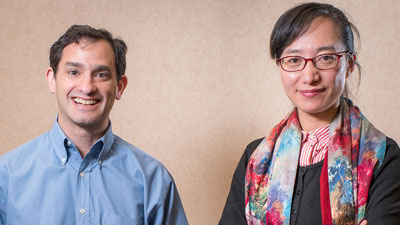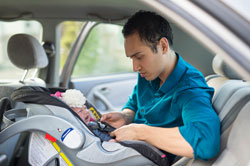Media contact: Yvonne Taunton
 Developmental psychologist Huarong Wang (right) spent a year in the UAB Youth Safety Lab, directed by David Schwebel (left)In China, as in the United States and the rest of the world, road traffic injuries are a leading killer of children five and over. And in more than one-fifth of cases, the children killed or injured are pedestrians, rather than vehicle occupants.
Developmental psychologist Huarong Wang (right) spent a year in the UAB Youth Safety Lab, directed by David Schwebel (left)In China, as in the United States and the rest of the world, road traffic injuries are a leading killer of children five and over. And in more than one-fifth of cases, the children killed or injured are pedestrians, rather than vehicle occupants.
Huarong Wang, Ph.D., who specializes in developmental psychology at China’s Nantong University, says regular news reports about children’s traffic injuries drew her into injury prevention research. The underlying causes of these injuries are complex, Wang says. They include developmental factors in the children themselves, she explains, but also the built traffic environment, family and school education and more: “We still have a lot of work to do.”
Virtual reality, real-world impact
As Wang studied the literature on traffic safety, she was intrigued by the work of UAB's David Schwebel, Ph.D., University Professor and director of the Youth Safety Lab in UAB’s Department of Psychology and associate dean for research in the UAB College of Arts and Sciences. She was particularly intrigued by his use of virtual reality software to study children’s pedestrian behaviors. “Dr. Schwebel’s research on child safety is very influential,” she says. “I often read his and his team’s papers, which provide me with a lot of research inspiration.” When she had the chance to study abroad, Wang immediately contacted Schwebel and got a “very positive response,” she says. She has spent the past year in Schwebel’s UAB Youth Safety Lab along with another visiting scholar, Yue Wu, Ph.D., from China’s Central South University in Changsha.
At UAB, Wang has learned to use Schwebel’s pedestrian virtual reality system and developed her own application of the technology. She is now using it for traffic safety research in her lab in China. That work is the subject of one of the five papers she and Schwebel have co-authored during her time in the United States.
Positive atmosphere
Wang has been impressed by the “efficient, energetic, positive and constructive” atmosphere in Schwebel’s lab, and inspired to apply what she has learned in everything from study design and participant recruitment to data coding and research ethics activities. She also has visited UAB’s TRIP Lab, led by associate professor Despina Stavrinos, Ph.D., which has a unique SUV driving simulator used for cutting-edge research in distracted driving and other transportation safety issues.
Outside the lab, Wang and her family have enjoyed Birmingham’s libraries, McWane Science Center, zoo and botanical gardens, as well as a trip to Orange Beach and Alabama’s Gulf Coast, and the theme parks of Orlando. “There are lots of activities for children — it’s great!” she says. “I am very grateful for this year’s visiting experience and feel very enriched.”

